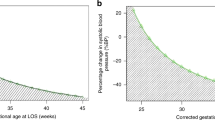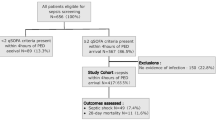Abstract
Objectives
To compare blood pressures (BP) between neonates with culture-proven sepsis and clinical sepsis in the first 120 h of sepsis onset and to examine association between BP and in-hospital mortality.
Methods
In this cohort study, consecutively enrolled neonates with ‘culture-proven’ sepsis [growth in blood/ cerebrospinal fluid (CSF) within 48 h] and clinical sepsis (sepsis workup negative, cultures sterile) were analyzed. Their BP was recorded every 3-hourly for initial 120 h and averaged in 20 time-epochs of 6 h each (0–6 h to 115–120 h). BP Z-scores were compared between neonates with culture-proven vs. clinical sepsis and survivors vs. non-survivors.
Results
Two hundred twenty eight neonates (102—culture-proven and 126—clinical sepsis) were enrolled. Both groups had comparable BP Z-scores except significantly lower diastolic BP (DBP) and mean BP (MBP) in 0–6 and 13–18 time-epochs in culture-proven sepsis group. Fifty-four neonates (24%) died during their hospital stay. BP Z-scores in the initial 54 h of sepsis were independently associated with mortality [systolic BP (SBP) Z-scores in first 54 h, DBP Z-scores in first 24 h, and MBP Z-scores in first 24 h] after adjusting for gestational age, birth weight, cesarean delivery, and 5-min Apgar score. On receiver operating characteristic curves, SBP Z-scores showed better discriminative ability than DBP and MBP to identify non-survivors.
Conclusions
Neonates with culture-proven and clinical sepsis had comparable BP Z-scores except low DBP and MBP in the initial few hours in culture-proven sepsis. BP in initial 54 h of sepsis was significantly associated with in-hospital mortality. SBP discriminated non-survivors better than DBP and MBP.
Similar content being viewed by others
References
Davis AL, Carcillo JA, Aneja RK, et al. American College of critical Care Medicine clinical practice parameters for hemodynamic support of pediatric and neonatal septic shock. Crit Care Med. 2017;45:1061–93.
Weiss SL, Peters MJ, Alhazzani W, et al. Surviving sepsis campaign international guidelines for the management of septic shock and sepsis-associated organ dysfunction in children. Pediatr Crit Care Med. 2020;21:e52–106.
Osborn DA, Evans N, Kluckow M. Clinical detection of low upper body blood flow in very premature infants using blood pressure, capillary refill time, and central-peripheral temperature difference. Arch Dis Child Fetal Neonatal Ed. 2004;89:F168–73.
Singh Y, Katheria AC, Vora F. Advances in diagnosis and management of hemodynamic instability in neonatal shock. Front Pediatr. 2018;6:2.
Goldstein B, Giroir B, Randolph A. International pediatric sepsis consensus conference: Definitions for sepsis and organ dysfunction in pediatrics. Pediatr Crit Care Med. 2005;6:2–8.
Zhu F, Baczynski M, Kharrat A, Ye XY, Weisz D, Jain A. Blood pressure, organ dysfunction, and mortality in preterm neonates with late-onset sepsis. Pediatr Res. 2022;92:498–504.
Lyu Y, Ye XY, Isayama T, et al. Admission systolic blood pressure and outcomes in preterm infants of = 26 weeks’ gestation</at. Am J Perinatol. 2017;34:1271–8.
Flynn JT, Kaelber DC, Baker-Smith CM, et al. Clinical practice guideline for screening and management of high blood pressure in children and adolescents. Pediatrics. 2017;140:e20171904.
Dionne JM, Bremner SA, Baygani SK, et al. Method of blood pressure measurement in neonates and infants: a systematic review and analysis. J Pediatr. 2020;221:23–31.e5.
Zubrow AB, Hulman S, Kushner H, Falkner B; Philadelphia Neonatal Blood Pressure Study Group. Determinants of blood pressure in infants admitted to neonatal intensive care units: a prospective multicenter study. J Perinatol. 1995;15:470–9.
Chiesa C, Natale F, Pascone R, et al. C reactive protein and procalcitonin: reference intervals for preterm and term newborns during the early neonatal period. Clin Chim Acta. 2011;412:1053–9.
Manroe BL, Weinberg AG, Rosenfeld CR, Browne R. The neonatal blood count in health and disease. I. reference values for neutrophilic cells. J Pediatr. 1979;95:89–98.
Mouzinho A, Rosenfeld CR, Sanchez PJ, Risser R. Revised reference ranges for circulating neutrophils in very-low-birth-weight neonates. Pediatrics. 1994;94:76–82.
Saini SS, Kumar P, Kumar RM. Hemodynamic changes in preterm neonates with septic shock: a prospective observational study. Pediatr Crit Care Med. 2014;15:443–50.
Funding
Shiv Sajan Saini received funding for this study from the Indian Council of Medical Research, New Delhi, India.
Author information
Authors and Affiliations
Contributions
SSS: Developed the protocol, performed analysis, supervised the patient recruitment, reviewed, and revised the manuscript, and approved the final manuscript as submitted; AKS: Supervised data collection, crosschecked data entry, organized data in excel spreadsheets, reviewed, and revised the manuscript, and approved the final manuscript as submitted; VS, SD, PK: Supervised the patient recruitment, reviewed, and revised the manuscript, and approved the final manuscript as submitted. PK will act as guarantor for this manuscript.
Corresponding author
Ethics declarations
Ethics Committee Approval
Institute’s Ethics Committee approved the study (Approval no IEC-04/2019 - 1231 Dated 13.05.2019).
Conflict of Interest
None.
Additional information
Publisher’s Note
Springer Nature remains neutral with regard to jurisdictional claims in published maps and institutional affiliations.
Electronic Supplementary Material
Below is the link to the electronic supplementary material.
Rights and permissions
Springer Nature or its licensor (e.g. a society or other partner) holds exclusive rights to this article under a publishing agreement with the author(s) or other rightsholder(s); author self-archiving of the accepted manuscript version of this article is solely governed by the terms of such publishing agreement and applicable law.
About this article
Cite this article
Saini, S.S., Shrivastav, A.K., Sundaram, V. et al. Early Blood Pressure Changes in Neonatal Sepsis and the Risk of Mortality. Indian J Pediatr 90, 1096–1102 (2023). https://doi.org/10.1007/s12098-023-04597-7
Received:
Accepted:
Published:
Issue Date:
DOI: https://doi.org/10.1007/s12098-023-04597-7




